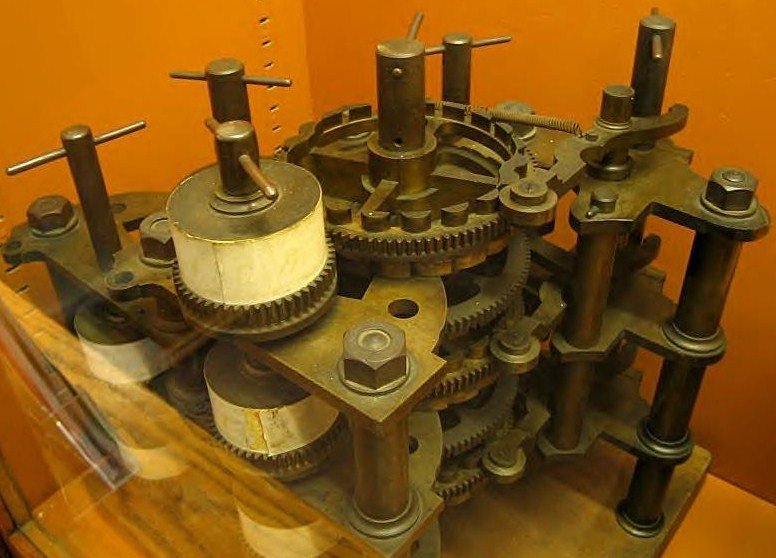Charles Babbage A Very Relevant Quote
1791-1871
|
Babbage sought a method by which
mathematical tables could be calculated mechanically, removing the high rate of
human error. Three different factors seem to have influenced him: a dislike of
untidiness; his experience working on
logarithmic tables; and existing work on
calculating machines carried out by
Wilhelm Schickard,
Blaise Pascal, and
Gottfried Leibniz. He first discussed the principles of a
calculating engine in a letter to Sir
Humphry Davy in 1822.
Babbage's
engines were among the first mechanical computers, although they were not
actually completed, largely because of funding problems and personality issues.
He directed the building of some steam-powered machines that achieved some
success, suggesting that calculations could be mechanized. Although Babbage's
machines were mechanical and unwieldy, their basic architecture was very similar
to a modern computer. The data and program memory were separated, operation was
instruction based, the control unit could make conditional jumps and the machine
had a separate
I/O unit.
In Babbage’s time numerical tables were
calculated by humans called ‘computers,’ meaning "one who computes," much as a
conductor is "one who conducts." At Cambridge he saw the high error rate of this
human-driven process and started his life’s work of trying to calculate the
tables mechanically. He began in 1822 with what he called the difference engine,
made to compute values of polynomial functions. Unlike similar efforts of the
time, Babbage's difference engine was created to calculate a series of values
automatically. By using the method of
finite differences, it was possible to avoid the need for
multiplication and division.
The
first
difference engine was composed of around 25,000 parts, weighed fifteen
tons (13,600 kg), and stood 8 ft (2.4 m) high. Although he
received ample funding for the project, it was never completed. He later
designed an improved version, "Difference Engine No. 2", which was not
constructed until 1989-1991, using Babbage's plans and 19th–century
manufacturing tolerances. It performed its first calculation at the London
Science Museum returning results to 31 digits, far more than the average modern
pocket calculator.
Babbage designed a
printer for the second difference engine which supported line-wrapping, variable
column and row width, and programmable output formatting. Soon after the attempt at making the difference engine crumbled, Babbage started designing a different, more complex machine called the Analytical Engine. The engine is not a single physical machine but a succession of designs that he tinkered with until his death in 1871. The main difference between the two engines is that the Analytical Engine could be programmed using punch cards, an idea unheard of in his time. He realized that programs could be put on similar cards so the person had to only create the program initially, and then put the cards in the machine and let it run.
|
The analytical engine was also proposed to use loops of Jacquard's punched cards to control a mechanical calculator, which could formulate results based on the results of preceding computations.
Ada Lovelace, an impressive mathematician and one of the few
people who fully understood Babbage's ideas, created a program for the
Analytical Engine. Had the Analytical Engine ever actually been built, her
program would have been able to calculate a sequence of
Bernoulli numbers. Based on this work, Lovelace is now widely
credited with being the first
computer programmer. In 1979, a
contemporary programming language was named
Ada in her honour. Shortly
afterward, in 1981, a satirical article by Tony Karp in the magazine
Datamation described the
Babbage
programming language as the "language of the future".
Babbage
also achieved notable results in
cryptography. He broke Vigenère's
autokey cipher as well as the much weaker cipher that is called
Vigenère cipher today. The
autokey cipher was generally called "the undecipherable cipher", though owing to
popular confusion, many thought that the weaker polyalphabetic cipher was the
"undecipherable" one. Babbage's discovery was used to aid English military
campaigns, and was not published until several years later; as a result credit
for the development was instead given to
Friedrich Kasiski, a Prussian infantry officer, who made the
same discovery some years after Babbage.
In 1838,
Babbage invented the
pilot (also called a
cow-catcher), the metal frame attached to the front of locomotives that clears
the tracks of obstacles. He also constructed a dynamometer car and performed
several studies on
Isambard Kingdom Brunel's
Great Western Railway in
about 1838. Babbage's eldest son, Benjamin Herschel Babbage, worked as an
engineer for Brunel on the railways before emigrating to Australia in the 1850s.
In
On the Economy of
Machine and Manufacture, Babbage described what is now called the
Babbage principle, which describes certain advantages with division of labor.
Babbage noted that highly skilled - and thus generally highly paid - workers
spend parts of their job performing tasks that are 'below' their skill level. If
the labor process can be divided among several workers, it is possible to assign
only high-skill tasks to high-skill and -cost workers and leave other working
tasks to less-skilled and paid workers, thereby cutting labor costs. This
principle was criticized by
Karl Marx who argued that it caused labour segregation and
contributed to
alienation. The Babbage principle is an
inherent assumption in
Frederick Winslow Taylor's
scientific management.
|

